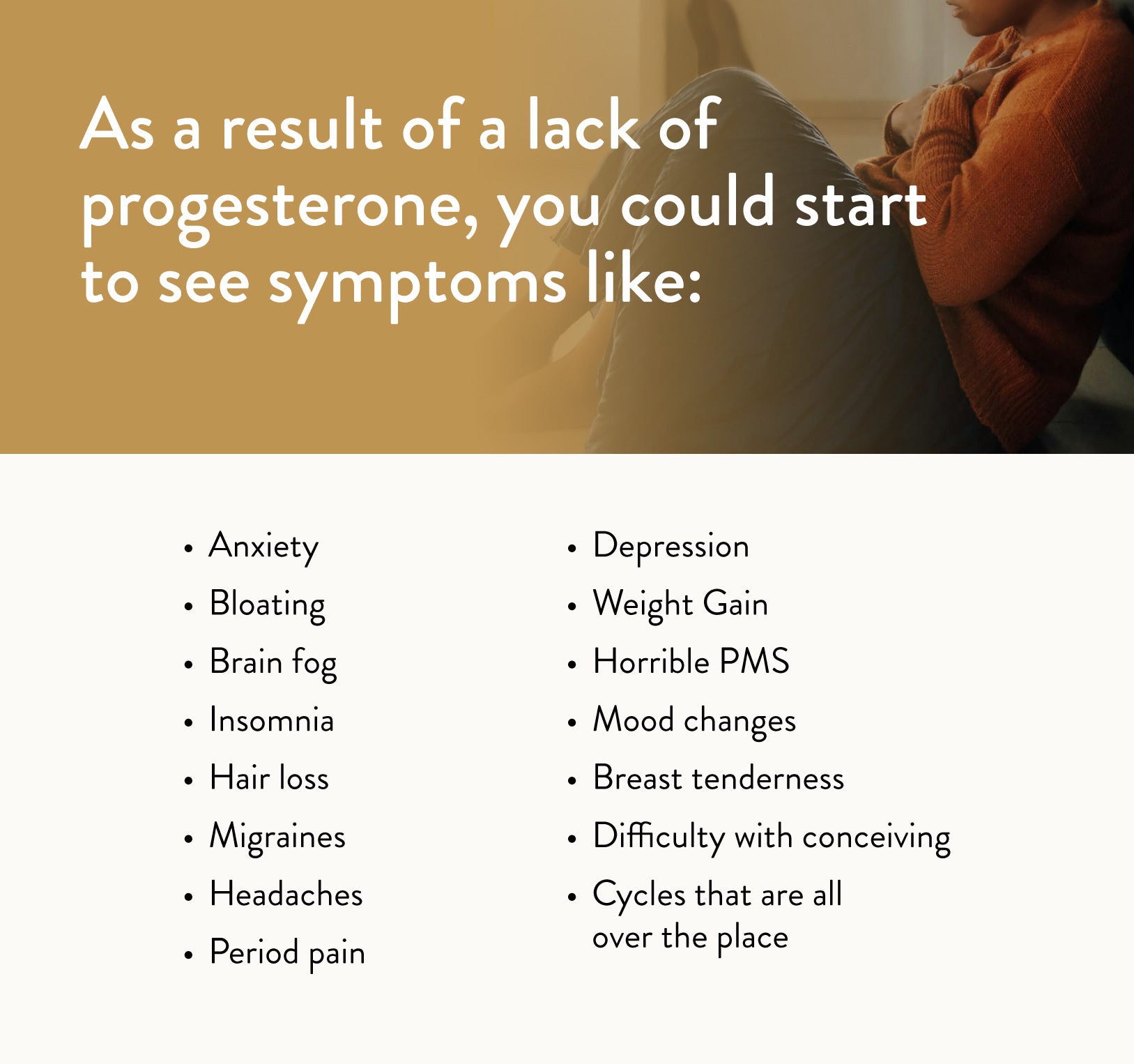We talk a lot about estrogen, especially in perimenopause and menopause. But there’s another hormone that’s equally important to women’s health (and sanity): progesterone. And honestly, it’s progesterone’s steep decline that can start in your 30s that really starts to kick off the difficult and debilitating perimenopause and menopause symptoms. So let’s talk about how to increase progesterone naturally.
Because if you’ve been suffering from headaches, migraines, wicked PMS, period pain, anxiety, depression, hot flashes, night sweats, or your cycle is unpredictable — a lack of sufficient progesterone is to blame.
There are things you can do to encourage progesterone naturally though. Let’s take a look at why you’d want to do that and how to make it happen.
Progesterone Vs. Progestin
First things first, let’s be clear here. When I’m talking about progesterone, I’m talking about the natural hormone that your body makes.
A lot of doctors and even researchers mistakenly use the word “progesterone” to describe a synthetic hormone known as progestin. Progestin is what’s in hormonal IUDs and the combination birth control pill.
Progestin and progesterone are totally different.
So just know that when your doctor says he’s going to prescribe “progesterone” he’s probably talking about progestin. And just so you’re aware — progestin is nothing like what your body makes on a biochemical level. It’s also the stuff that you’ve likely heard warnings about, because it comes with some pretty scary side effects.
Progesterone’s Role In The Body
Progesterone is mainly produced in the body after you ovulate. (1) When you’re still cycling, basically what happens is this: each month, your body chooses one dominant follicle that contains an egg to be the “chosen one.” The egg then bursts out of the follicle onto the ovarian surface and travels into the fallopian tube and then to the uterus.
The cells of the follicle that get left behind form the corpus luteum, a temporary structure that releases progesterone. (2) The idea is that if you get pregnant, you will need progesterone to help support the pregnancy.
But progesterone does so much more than just support the early stages of pregnancy.
It is the calming foil to estrogen’s exciting (ok, crazy) influence.
It also supports your heart and nervous system. Progesterone is absolutely critical for your brain.
It’s not just a “pregnancy hormone” as many people assume.
Progesterone In Perimenopause And Menopause
Here’s where the problem lies…as you age, you ovulate less. That’s the basic point of menopause. Your body stops preparing you to get pregnant every month, so it doesn’t release an egg reliably every single time.
So when you don’t ovulate you don’t produce very much progesterone.
Now, if you have other hormone imbalances, notably endometriosis, thyroid disease, or polycystic ovarian syndrome (PCOS) your body may not ovulate regularly, either. Same if you’re suffering from an eating disorder or exercising too hard. Stress can cause your progesterone levels to decrease too. So it’s not necessarily just menopause that causes this decrease in progesterone to happen. It’s important to investigate the cause of anovulation.
For a lot of women, these anovulatory, perimenopause-induced cycles start to happen in their mid-thirties. This results in a sharp and sudden drop in progesterone levels. But unless you’re actively trying to conceive or just a really keen observer of your cycle — you probably won’t know whether you’re ovulating or not. You’ll just start to notice some very uncomfortable things start to happen in your body. You may just write these symptoms off as completely unrelated to your hormones.
Why?
Because progesterone isn’t there, helping to counteract estrogen’s crazy effect on your mood, your cycle, and your PMS symptoms.
Progesterone isn’t there to help you get to sleep.
Progesterone isn’t there to calm your brain down and stop the anxious thoughts.
How To Increase Progesterone Naturally
So we know that progesterone is incredibly important for your body. And we know that when it isn’t hanging around in abundance, it can have serious impacts on your mood and your quality of life.
We also know that ovulation is how you get the majority of your sweet, sweet progesterone.
And we know that as you age you ovulate less and less.
So let’s look at some of the ways you can “cheat the system” and get more progesterone without necessarily having to ovulate.
Here are some of my favorite natural ways to increase progesterone

One of my favorite progesterone boosters is to simply reduce stress. OK, I know that’s not always necessarily “simple” to do. But it’s important.
You see your stress hormone, cortisol, is made in the adrenal glands. One of the things it’s made from is progesterone. So when you’re stressed, and your body is producing cortisol as a result — you’re not going to be producing progesterone. That’s a big deal for any woman who’s already low on progesterone.
Some of my favorite stress reduction techniques are exercise, yoga, and generally learning to say “no” to what just doesn’t serve you. Again, maybe not easy, but important.
Also, when you prioritize your relationships and connection with others, you prioritize oxytocin, a hormone that keeps cortisol in check. So snuggle with your loved ones and pets and laugh and love your life. It will help you in the progesterone department.

Healthy fats are an essential part of any diet, but they are particularly important if you’re looking to increase progesterone naturally.
This is because your adrenal glands are like a backup generator for your hormones. When they aren’t producing cortisol, your adrenals can focus on turning cholesterol into hormones like pregnenolone and then progesterone. This can serve as a nice little backup source of progesterone when your ovaries are no longer ovulating.

Unfortunately, there aren’t really a bunch of foods with progesterone in them. But it’s important to make sure your body has everything it needs to function at its best and create hormones to the best of its ability.
Some important nutrients you want to make sure you’re getting enough of include:
Zinc
Zinc is a crucial part of the ovulation process because it’s necessary for your pituitary gland to signal follicle-stimulating hormone (FSH) which kind of kicks off the ovulation process. Zinc is found in foods like beef, oysters, pumpkin seeds, and chickpeas. You can also supplement with zinc if you aren’t getting enough of it in your diet.
Selenium
Selenium is another mineral that’s required for ovulation. This is why it’s become popular recently to have a couple of Brazil nuts a day — they are sources of selenium and can support hormone balance. Selenium is one of the key ingredients in my Bright & Beautiful formula that helps your hormones and your skin, hair, and eyes simply glow from within.
Vitamin C
Vitamin C actually can increase the effects of progesterone in the body. Vitamin C is overall such a wonderful nutrient for your health and your hormones that I often recommend it to my patients as a way to support your adrenal glands and encourage progesterone production. Vitamin C is found in foods like citrus fruits and broccoli, but I take it as a supplement daily.
Vitamin B6
Vitamin B6 is one of those nutrients that help your hormones on many levels. It has even been studied as a treatment for premenstrual syndrome (PMS) and premenstrual dysphoric disorder (PMDD). (3) I actually combine B6 with zinc for the ultimate progesterone support in my Amazinc formula.
Magnesium
Magnesium is a superstar for your hormones. It helps manage cramps and can help you relax and sleep better. Plus, it’s a part of your progesterone receptor function. It’s also incredibly important for about 300 other reactions in your body and it’s absolutely essential for your brain. Magnesium is abundant in foods like spinach and almonds. When considering a supplement, be sure to get a formula like my Better Brain and Sleep powder that includes highly bioavailable forms of magnesium that cross the blood-brain barrier and won’t make you run to the bathroom.

Sleep is your hormone’s best friend. Trouble is, when your progesterone is low, that can wreak havoc on your ability to fall asleep and stay asleep. This is why sleep challenges are one of the most common complaints for women in menopause. Keep in mind, while you’re working on getting your progesterone levels up, you may want to leverage a little help in the sleep department.

At the beginning of this article, I warned you about the dangers of synthetic progesterone, also known as progestin.
But there’s another, healthier option to naturally increase progesterone.
It’s known as bioidentical progesterone. And it’s exactly the same as what your body makes. Down to the last molecule.
For many women later in perimenopause and menopause — this is the most viable option for alleviating those difficult symptoms because your body just needs more progesterone than you can trick it into making.
Bioidentical progesterone typically comes in a cream that you rub on your skin. That’s because your liver breaks down progesterone quite quickly. So if you were to take it in a pill form, you’d have to take a lot to get it into the bloodstream. A topical formula allows you to bypass the liver and start feeling better faster.
Bioidentical progesterone is the secret weapon that many women find helps you to sleep better, ease hot flashes, and keep your mood more even. Bioidentical progesterone also helps to regulate the menstrual cycle and reduce PMS when you’re still cycling. That’s the power of having enough progesterone circulating in your body!
My proprietary formula, Balance, includes pregnenolone and progesterone for full-spectrum hormonal support. It also doubles as a luxury night cream. You can learn more about this powerful formula here.
As always, make sure you consult with your doctor before starting any kind of hormone therapy.
How Long Does It Take To Increase Progesterone Levels?
When you start off on a journey to boost progesterone naturally, it can take time.
So don’t worry if you don’t immediately see results from implementing these progesterone-boosting strategies.
Keep tweaking your stress reduction techniques. Keep improving your sleep. Keep eating all of your crucial nutrients. And don’t be afraid to add in some extra support from over-the-counter topical bioidentical progesterone if that’s what your doctor recommends.






